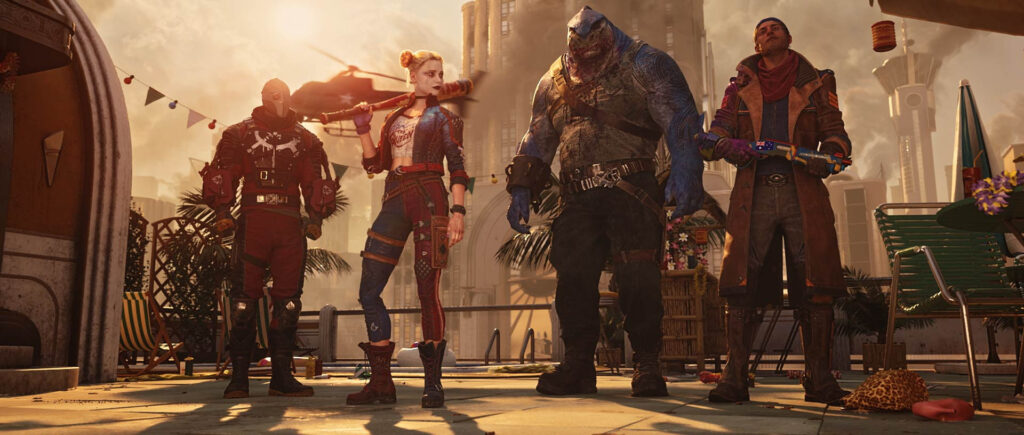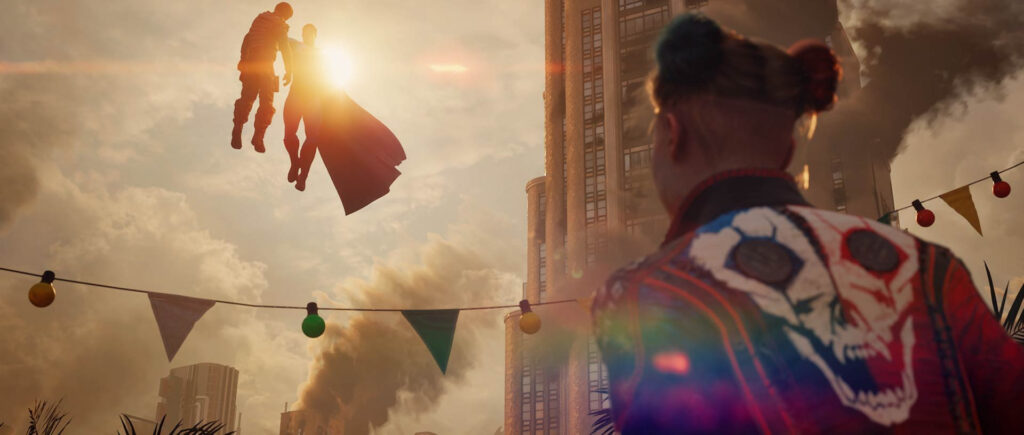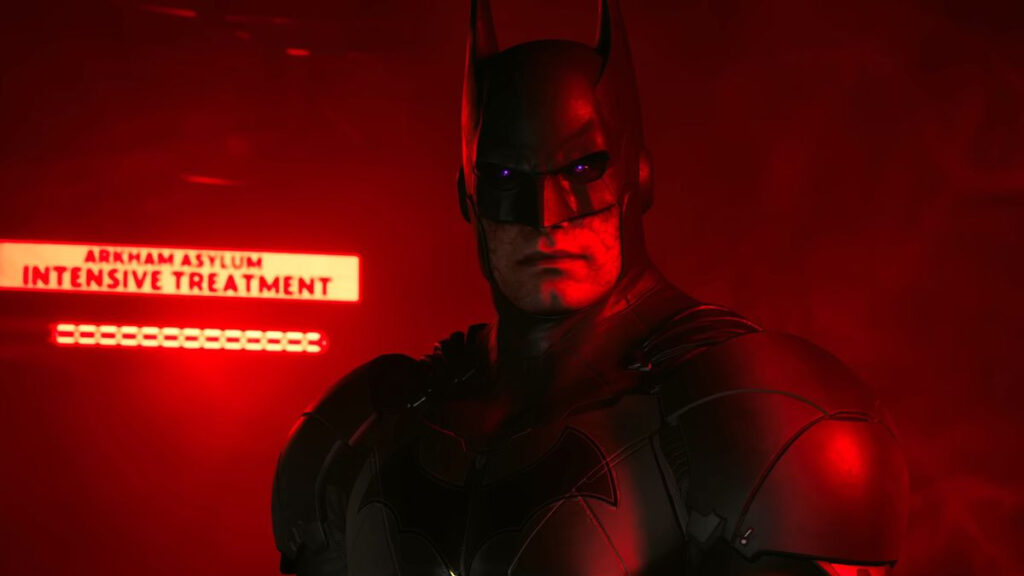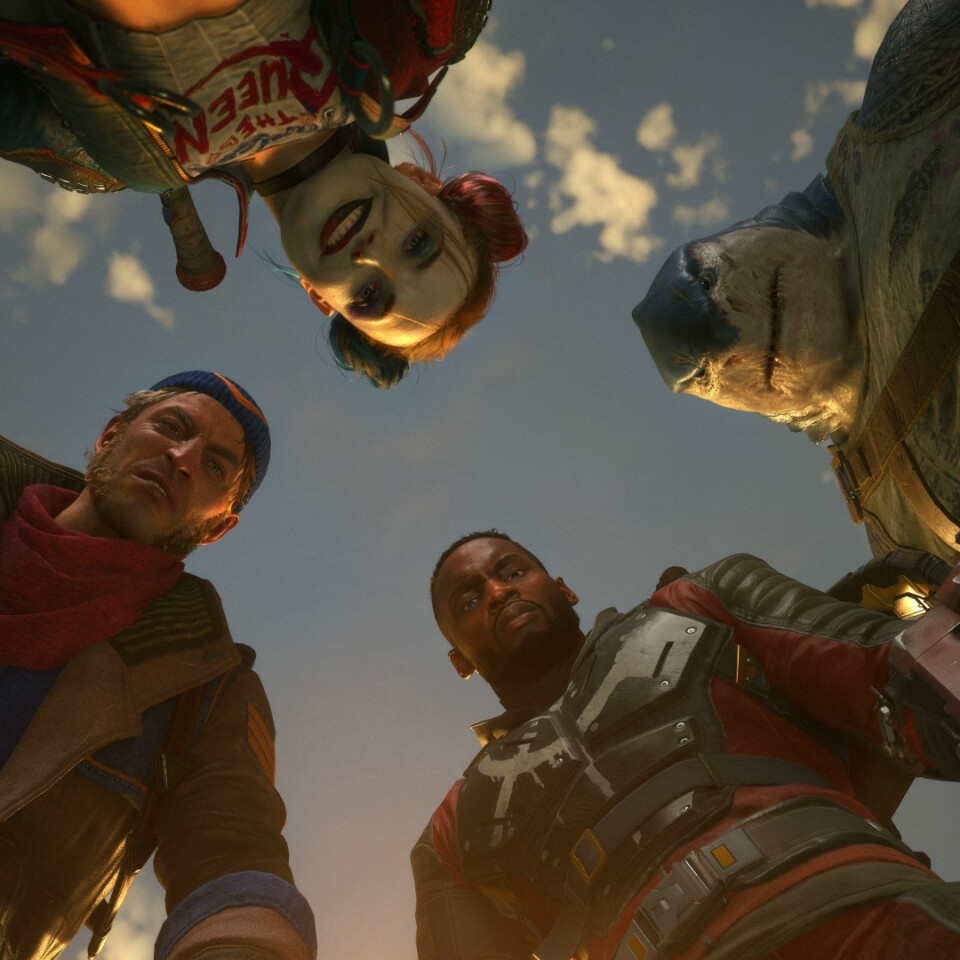How do you move on from the Arkham series? It’s simple. We, uh, kill the Batman. (And the rest of the Justice League, while we’re at it.)
“We’re not the Batman. We’ll never be the Batman. We’re just the overworked, underappreciated B-team.” That is the crux of – and, many would argue, the problem with – Suicide Squad: Kill the Justice League. The speaker is Deadshot, who specialises in high-tech weaponry, most of which is belted and buckled onto his body, along with a jetpack that scuds him over the rooftops. Joining him is Digger Harkness, otherwise known as Boomerang (Captain Boomerang, if you wish to flatter him). He throws boomerangs at people. There is also Harley Quinn, former paramour of the Joker, who still enjoys coating her face in clownish paint. Finally, we have King Shark, who is, sure enough, a shark. Though he sports a charming floral-print vest. All in all, Deadshot was spot on with his assessment, though he does miss one point: Given the calibre of he and his comrades, isn’t “B” a little generous?
This scattershot crew are plucked from their cells at Arkham Asylum and summoned to the attention of Amanda Waller, who oversees an echelon of government so shadowy that even Sam Fisher would need to crank up the brightness on his goggles when getting briefed. Each of the four is injected with a miniature bomb at the base of the neck; disobey orders, and they will be relieved of their craniums. Though, as Harley Quinn points out, “I don’t think about my brain detonating more than usual.” The situation is dire. The Justice League, comprising Wonder Woman, Superman, Batman, The Flash, and Green Lantern, has gone rogue. Thanks to a purple alien named Brainiac, they are all now devoted to the planet’s ruin – with the exception of Wonder Woman, who, for reasons unknown, is able to resist her foe’s mind-melting power.
The mission is simple, and spelled out in no uncertain terms by the game’s title. These four villains must club together and bring down their betters. “You’re behind enemy lines in occupied Metropolis,” says Waller. “Maybe the most dangerous place on Earth.” It’s not a bad pitch for an action caper, but the developer is Rocksteady Studios, which hasn’t released a game since Batman: Arkham Knight, in 2015. The weight of not just hype, but a kind of pre-installed deflation, has been gathering for a long while. When the project was officially announced, in 2020, the world had already suffered one Suicide Squad movie and was bravely staring down a second. As undeniably talented as the folks at Rocksteady are, it was tough not to think, Really? This is where you want to go next, the guy with the boomerang?

To make matters worse, Suicide Squad: Kill the Justice League is also a loot-encrusted live-service shooter, rather than another brooding slab of single-player Batman – on which Rocksteady has chiselled its impeccable reputation. Could the game’s narrative, written by Ian Ball and Sefton Hill (the latter of whom co-founded, and has now left, the studio), have been devised in subversive protest? Or is it merely coincidence that we must battle a lofty, and mostly absent, superior who has filled the heads of the world’s leading superhero team with questionable ideas? In any event, here’s the killing joke: it’s actually pretty good.
This ought not to be a shock. When it comes to movement and combat, Rocksteady has few peers. No other developer has made such music from the rhythmic snap of broken bones; granted, Batman’s rubbery brand of non-lethal engagement has been traded here for the nastier kind, but as far back as Urban Chaos: Riot Response, the studio’s debut, it has proved its credentials with firearms. That was a cop thriller that got its kicks from the regular beat of violence – the familiar patterns of punched glass and shell casings that curl through the air. Harley and her fellow-crooks tote rifles, baseball bats, and knives, but they strike the same chord as the Arkham series when it comes to the lull and surge of a good fray.
You counter opponents by shooting them just before they pounce, and you pepper them with gunfire at a distance before closing the gap and getting personal. Each of the quartet has different means of zipping around. Boomerang, having thieved a thingamajig from the Hall of Justice (a museum dedicated to the League), has the power to run as quick as The Flash, but only as far as he can throw one of his namesakes. King Shark likes to leap and swipe his arms in a mock breaststroke. Harley uses one of Batman’s old grapple hooks and swings from an aerial Bat-drone as though it were a trapeze. Meanwhile, Deadshot hovers overhead, courtesy of his jetpack. The combat is looser than that of the Arkham games, crammed with goons but aerated, spread over city blocks and crackling with far-off threat. It’s harder to find a flow in the bedlam, but when you do you’re reminded of what this developer can do that so few can. Steeped in urban chaos, the response is a riot.

“Mobility is your strongest asset – sure ain’t your smarts or your tactics.” So says Rick Flag, one of Waller’s more unflappable subordinates, with a boring buzz cut and not much of a character. He could be delivering a verdict on the game itself. Your tactics don’t waver (“I scan, the enemies show up, you engage. You got that?” says Rick), and your smarts mostly come from Lex Luthor, who rocks up in a lime-green mech suit and donates his giant malevolent mind to the cause. But Rocksteady wisely applies the pace, and you are whipped through the plot with enough speed that most of its holes barely register.
This story is, supposedly, a follow-on from the Bat-triptych that began in 2009. But I can’t help feeling that it didn’t start out that way. Deadshot has been recast, his new iteration much closer to Will Smith’s turn in the 2016 movie, with a daughter that he’s desperate not to see only at long range. Harley is a completely different character than she was; when suiting up, she greets her old outfit (corset, frills, choker) with a frown and a “Yeah, right,” and she says to Poison Ivy, at one point, “We’ve been through worse together . . . like knowin’ my ex!” Since when? The last time we saw her she was nothing but weepily devoted to her dead swain. Fair enough, she has to be more here than the broken-doll widow that she was, but in the absence of any real development the alterations feel like lurches.
Then there is Ivy herself, whom you may remember wilting into expiration at the close of Arkham Knight. Here she is, inexplicably alive, for some reason a child, and replanted into Metropolis. True, she looks great, with a head of copper-coloured leaves and sickly yellow skin, but, beyond a budding resentment of human beings, what relation does she bear to the person she was? The thinking, I suppose, is that fans will feel gratified by the notion that the new game is more of what they once loved – not least because the Batman of old puts in an appearance, voiced by the late Kevin Conroy, who has a high old time in a new low role.

The trouble, really, is that he shouldn’t be here. Batman, of course, belongs in the League, but this Batman overshadows his villainous peers, as if they were crouched under his cape. Whereas he regularly mocks you over the airwaves, the others get less screen time – not so much a problem with The Flash or Green Lantern, neither of whom could hope to outrun or outshine the rest. But it’s a shame that Wonder Woman has so little to work with. What we see of her is intriguing – stoic, kind, shot through with imperious nobility – maybe all the more for it being cut short, but you wonder if she shouldn’t have had a game to herself. Best of all is Superman, who is voiced by Nolan North. As he floats down from on high, fists on his hips, eyes empurpled and gleaming, it’s a genuinely scary sight. If only Amazon hadn’t already given us The Boys, in which the spectacle of a homicidal god – a man whose morals have been curdled, rather than spangled, by his powers – were done better, with a deeper chill, in the figure of Homelander.
You long for a Superman adventure with Rocksteady at the helm. Not least because, if anyone could get that right, it’s this studio, but also because of Metropolis. It is the greatest casualty of the game’s premise: ensnared in vast, metallic tentacles, pocked with craters and smoky rubble, its splendour still shows through. It’s a dream of Art Deco, all swooping skyways and gilded monorails; the cars could have come straight from Fallout, with their tail fins and their fifties heft; and there is a Jazz Age futurism to some of its vistas. One moment, I saw a billboard for a fashion label, with a woman striking a flapper-girl pose and wearing a cloche hat. It’s America in its most dream-bright decades, blurred together like headlines rolling off the presses. “Humanity isn’t welcome here,” says Waller, and she’s right. We scarcely see another soul, and we spend the game battling disposable monsters. But the best glimpses of Suicide Squad: Kill the Justice League are when you ignore your orders and go after signs of life. Be careful. A little disobedience and you might get your mind blown.
Game: Suicide Squad: Kill the Justice League
Platform: PC / PlayStation 5 / Xbox Series X|S
Developer: Rocksteady Studios
Publisher: Warner Bros. Games
Release Date: February 2, 2024






